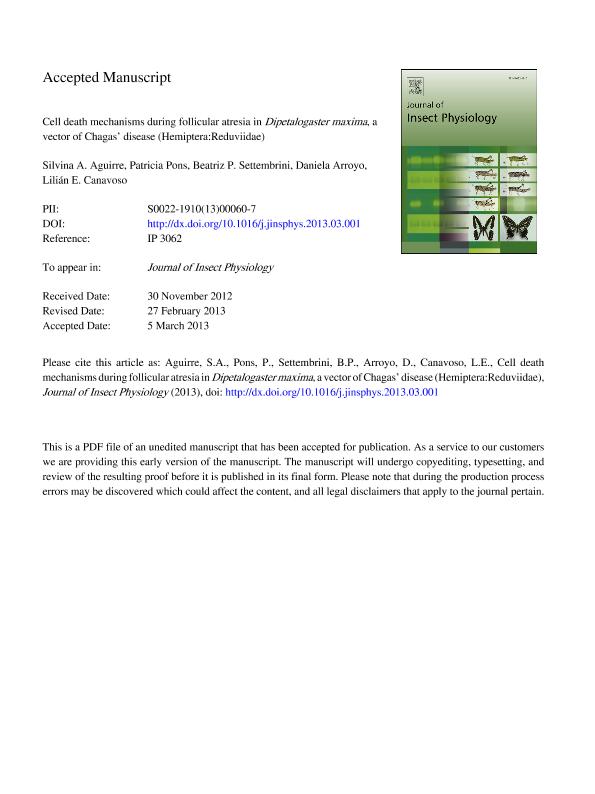Mostrar el registro sencillo del ítem
dc.contributor.author
Aguirre, Silvina Andrea

dc.contributor.author
Pons, Patricia

dc.contributor.author
Settembrini, Beatriz Patricia

dc.contributor.author
Arroyo, Daniela Soledad

dc.contributor.author
Canavoso, Lilian Etelvina

dc.date.available
2020-04-03T20:57:52Z
dc.date.issued
2013-05
dc.identifier.citation
Aguirre, Silvina Andrea; Pons, Patricia; Settembrini, Beatriz Patricia; Arroyo, Daniela Soledad; Canavoso, Lilian Etelvina; Cell death mechanisms during follicular atresia in Dipetalogaster maxima, a vector of Chagas' disease (Hemiptera: Reduviidae); Pergamon-Elsevier Science Ltd; Journal of Insect Physiology; 59; 5-2013; 532-541
dc.identifier.issn
0022-1910
dc.identifier.uri
http://hdl.handle.net/11336/101974
dc.description.abstract
In this work wehave analyzed the involvement of cell death pathways during the process of follicular atresia in the hematophagous insect vector Dipetalogaster maxima. Standardized insect rearing conditions were established to induce agradual follicular degeneration stage bydepriving females ofblood meal during post-vitellogenesis. Wefirstcharacterized the morpho-histological and ultrastructural changes of the ovarian tissue at early and late follicular atresia by light and transmission electron microscopy. Apoptosis was investigated by DAPI nuclear staining, TUNEL labeling and the detection ofactive caspase-3 by immunofluorescence. Autophagy was assessed bythe measurement ofacid phosphatase activ- ity in ovarian homogenates and monitor edbythe detection ofthe specificmarker ofautophagic compartments, LC3. High levels of acid phosphatase activity were detected at all atretic stages. However, follicular cells of follicles undergoing incipient degeneration in early atresia exhibited features of apoptosis such as chromatin condensation,DNA fragmentation and the presence of active caspase-3. The ultrastructural findings and the increased levels of LC3-II found at late follicular atresia supported the relevance of autophagy at this atretic stage, although the extent of autophagosome formation demonstrated that this cell death pathway also occurred at early atresia. In late atresia,follicular cells also displayed more drastic changes compatible with necrosis. Taken together, results showed that apoptosis, autophagy and necrosis were operative during follicular atresia in D. maxima. Moreover, it was shown that the relevance of these cell death mechanisms correlate swith the time elapsed since the onset of the degenerative process.
dc.format
application/pdf
dc.language.iso
eng
dc.publisher
Pergamon-Elsevier Science Ltd

dc.rights
info:eu-repo/semantics/openAccess
dc.rights.uri
https://creativecommons.org/licenses/by-nc-sa/2.5/ar/
dc.subject
DIPETALOGASTER MAXIMA
dc.subject
REPRODUCTION
dc.subject
FOLLICULAR ATRESIA
dc.subject
APOPTOSIS
dc.subject
AUTOPHAGY
dc.subject.classification
Biología del Desarrollo

dc.subject.classification
Ciencias Biológicas

dc.subject.classification
CIENCIAS NATURALES Y EXACTAS

dc.title
Cell death mechanisms during follicular atresia in Dipetalogaster maxima, a vector of Chagas' disease (Hemiptera: Reduviidae)
dc.type
info:eu-repo/semantics/article
dc.type
info:ar-repo/semantics/artículo
dc.type
info:eu-repo/semantics/publishedVersion
dc.date.updated
2020-04-02T15:08:37Z
dc.journal.volume
59
dc.journal.pagination
532-541
dc.journal.pais
Estados Unidos

dc.journal.ciudad
Amsterdam
dc.description.fil
Fil: Aguirre, Silvina Andrea. Consejo Nacional de Investigaciones Científicas y Técnicas. Centro Científico Tecnológico Córdoba. Centro de Investigaciones en Bioquímica Clínica e Inmunología; Argentina
dc.description.fil
Fil: Pons, Patricia. Universidad Nacional de Córdoba. Facultad de Medicina. Centro de Microscopía Electrónica; Argentina
dc.description.fil
Fil: Settembrini, Beatriz Patricia. Consejo Nacional de Investigaciones Científicas y Técnicas. Oficina de Coordinación Administrativa Parque Centenario. Museo Argentino de Ciencias Naturales "Bernardino Rivadavia"; Argentina
dc.description.fil
Fil: Arroyo, Daniela Soledad. Consejo Nacional de Investigaciones Científicas y Técnicas. Centro Científico Tecnológico Córdoba. Centro de Investigaciones en Bioquímica Clínica e Inmunología; Argentina
dc.description.fil
Fil: Canavoso, Lilian Etelvina. Consejo Nacional de Investigaciones Científicas y Técnicas. Centro Científico Tecnológico Córdoba. Centro de Investigaciones en Bioquímica Clínica e Inmunología; Argentina
dc.journal.title
Journal of Insect Physiology

dc.relation.alternativeid
info:eu-repo/semantics/altIdentifier/url/http://www.sciencedirect.com/science/article/pii/S0022191013000607
dc.relation.alternativeid
info:eu-repo/semantics/altIdentifier/doi/http://dx.doi.org/10.1016/j.jinsphys.2013.03.001
Archivos asociados
